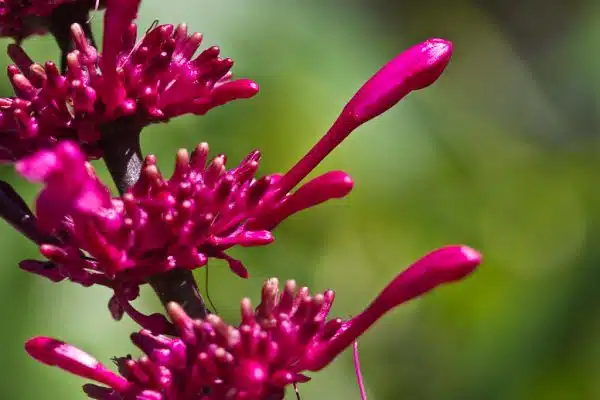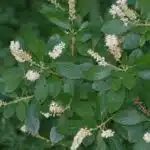Firespike plant, scientifically known as Odontonema strictum, is a tropical shrub that belongs to the Acanthaceae family. The plant is native to Mexico and Central America but has become popular among horticulturists due to its ornamental value. Firespike plants are known for their vibrant red flowers that bloom in late summer through fall and attract hummingbirds and butterflies. The plant grows up to six feet tall and requires minimal care, making it an ideal addition to any garden.
Growing firespike plants can be a rewarding experience for any gardening enthusiast. However, proper care is crucial to ensure that the plant thrives and produces beautiful blooms year after year. In this article, we will explore how to grow and care for firespike plants from selecting the right location to pruning and fertilizing techniques. By following these guidelines, you can create a stunning garden display while providing a habitat for pollinators such as butterflies and hummingbirds.
Getting Started: Selecting The Right Location
Did you know that firespike plants are native to Central and South America? These vibrant red flowers are a popular choice for gardeners who want to add a pop of color to their outdoor space. However, before you start planting these beauties, there are a few things you should consider.
The first thing you need to think about is the location. Firespike plants prefer well-draining soil that is rich in organic matter. They also require full sun or partial shade, depending on your climate. If you live in an area with hot summers, it’s best to plant them in a spot that gets some shade during the hottest part of the day.
When selecting a spot for your firespike plants, make sure it’s not too close to any trees or shrubs that could compete for nutrients and water. Additionally, avoid areas with heavy foot traffic or where pets may dig around the roots. By taking these factors into consideration when choosing the location for your firespike plants, you’ll be setting them up for success and ensuring they thrive in their new home.
Understanding firespike plant basics will help ensure your plants receive proper care and maintenance throughout their growth cycle. From watering techniques to pruning methods, we’ll cover everything you need to know about caring for these beautiful flowers in our next section.
Understanding Firespike Plant Basics
Firespike, scientifically known as Odontonema strictum, is a perennial plant that belongs to the Acanthus family. It is native to Central and South America and can grow up to six feet tall. The plant has bright red tubular flowers that bloom in late summer and early fall, making it an excellent choice for gardeners looking to add some color to their landscape.
Understanding the basics of firespike plants is crucial when growing and caring for them. The growing season for firespike plants typically starts in early spring and lasts through late fall. During this time, the plant produces new growth, flowers, and seeds. Firespikes prefer warm temperatures, making them ideal for areas with a tropical or subtropical climate. They thrive in full sun or partial shade and require well-draining soil.
Climate requirements are an essential consideration when deciding whether to grow firespike plants. They are hardy in USDA zones 8-11 but can be grown as annuals in cooler climates. In these areas, they should be planted after the last frost date and treated as annuals. Firespikes require moist soil during the growing season but do not tolerate standing water. It’s important to water them regularly during dry periods to prevent wilting or leaf drop.
- Growing firespike plants can evoke feelings of joy and happiness due to their vibrant red flowers.
- Adding firespikes to your landscape can create a sense of tranquility by attracting bees, butterflies, and hummingbirds.
- Caring for these beautiful plants can also evoke a sense of pride knowing you are contributing positively to the environment.
Moving forward into soil preparation and planting, it’s important first to consider drainage as firespikes detest standing water around their roots.
Soil Preparation And Planting
Now that we have a basic understanding of the firespike plant, let’s move on to soil preparation and planting. To ensure optimal growth and development of your firespike, it is essential to choose the right location with well-draining soil. These plants prefer moist, fertile soils but can tolerate a range of soil types.
Before planting, prepare the soil by amending it with organic matter such as compost or aged manure. This will help improve soil structure and fertility. Firespikes should be planted at least three feet apart from each other to allow for adequate air circulation and prevent disease spread. Once planted, mulch around the base of the plant to retain moisture, suppress weeds, and regulate soil temperature.
To encourage healthy growth throughout the growing season, fertilize your firespikes every six weeks with a balanced fertilizer such as 10-10-10 or 20-20-20. Avoid over-fertilizing as this can lead to excessive leaf growth at the expense of flower production. Additionally, using slow-release fertilizers can help provide longer-lasting nutrient availability for your plant.
When it comes to mulching techniques and fertilizer options for your firespike plants, there are various methods you can use depending on your climate and personal preferences. Experiment with different techniques to find what works best for you and always follow package instructions when using fertilizers. In the next section, we will discuss watering and feeding your firespike plant in more detail to ensure optimal growth and blooming potential.
Watering And Feeding Your Firespike Plant
Watering and feeding your firespike plant is crucial to its growth and overall health. Firespike plants are known for their need for consistent moisture, so it’s important to keep the soil consistently moist but not waterlogged. Depending on the climate, this may mean watering every few days or once a week. It’s important to check the soil regularly to ensure that it does not dry out completely.
When it comes to fertilizing your firespike plant, it’s best to use a balanced fertilizer with equal parts nitrogen, phosphorus, and potassium. This will help promote healthy foliage growth as well as encourage flowering. Fertilize your plant every four weeks during the growing season, which typically runs from spring through fall. Avoid fertilizing during the winter months when the plant is in a state of dormancy.
Proper watering frequency and fertilization schedule are key components of caring for your firespike plant. By providing consistent moisture and balanced nutrients, you can ensure that your plant grows strong and healthy. In the next section, we’ll discuss pruning and maintenance tips that will help keep your firespike looking its best year-round.
Pruning And Maintenance Tips
One of the most common misconceptions about firespike plants is that they require heavy pruning to maintain their shape and health. However, this belief couldn’t be further from the truth. Firespikes are relatively low-maintenance plants that require minimal pruning to keep them looking their best. In fact, over-pruning can lead to stunted growth, reduced flower production, and even death in extreme cases.
When it comes to pruning firespike plants, it’s important to use the right tools for the job. Sharp bypass pruners are an excellent choice for removing dead or damaged branches, while loppers are better suited for thicker stems or larger growth that needs trimming. Avoid using dull or rusty tools as they can damage the plant tissue and increase the risk of infection.
One of the most common mistakes made when pruning firespike plants is cutting back too much foliage at once. This can shock the plant and cause it to produce fewer flowers or even die off completely. Instead, focus on removing only dead or damaged growth as you see it throughout the year. If your firespike has grown too large for its space, consider transplanting it to a larger area rather than heavily pruning it back all at once.
Moving forward into dealing with pests and diseases, one of the most important things you can do is maintain good hygiene in your garden space. This includes regularly removing fallen leaves and debris from around your firespike plants as these can harbor pests and disease-causing organisms. Additionally, inspect your plants regularly for signs of infestation or infection so that you can take swift action if needed.
Dealing With Pests And Diseases
After pruning and maintaining your firespike plants, it is important to keep an eye out for any potential pests or diseases that may affect the plant’s health. Prevention is key to ensuring a healthy plant, and there are several natural remedies you can use to tackle these issues without resorting to chemical treatments.
One common issue with firespike plants is spider mites, which can be prevented by regularly misting the leaves with water and keeping the humidity levels high. You can also introduce natural predators such as ladybugs or lacewings to control spider mite populations. If you do need to use a chemical treatment, make sure to follow the instructions carefully and avoid spraying during hot weather.
Another common problem is fungal diseases such as leaf spot or powdery mildew. To avoid these issues, ensure good air circulation around the plant by trimming back any overcrowded branches. Additionally, watering at soil level rather than on the leaves can help prevent moisture buildup that contributes to fungal growth. If necessary, you can use natural fungicides such as neem oil or baking soda solutions to combat these diseases.
To summarize, while prevention is always preferable when it comes to pests and diseases affecting your firespike plant, there are natural remedies available if needed. Try misting regularly for spider mites and promoting good air circulation for fungal diseases before resorting to chemical treatments. With proper care and attention, your firespike plant should thrive in your garden for years to come.
Moving on from dealing with pests and diseases in firespike plants, let’s take a look at propagation techniques that will allow you to expand your collection of these beautiful plants.
Propagation Techniques
Cuttings are one of the most popular propagation techniques for firespike plants. The cuttings should be taken from a healthy parent plant and planted in moist, well-draining soil. Grafting is another propagation technique for firespike plants and involves taking a cutting of a desired variety and attaching it to a rooted parent plant. Layering is a propagation technique that involves bending the stem of a healthy parent plant and burying it in the soil to encourage root formation. To ensure success, the stem should be kept in contact with the soil and the soil should be kept moist. All of these propagation techniques can be used to successfully grow and care for firespike plants.
Cuttings
To propagate Firespike plants, gardeners can use various propagating techniques, including cuttings. Cuttings are an excellent way to grow new plants from existing ones. With the right care and attention, Firespike cuttings can root quickly and easily.
Before taking a cutting, it is essential to prepare the plant by watering it thoroughly a day before. Select a stem that is healthy and has no flowers or buds. Using clean and sharp pruning shears, make a diagonal cut just below a node where leaves emerge from the stem. Dip the cut end of the stem into rooting hormone powder before planting it in well-draining soil.
Once planted, cover the pot with a clear plastic bag to create a humid environment for the cutting. Place it in bright but indirect light and ensure that the soil remains moist but not waterlogged. Within four to six weeks, new roots will begin to form, indicating successful propagation. By following these simple steps, gardeners can propagate their Firespike plants effortlessly and enjoy their vibrant red blooms year-round.
Grafting
Propagation is a crucial aspect of gardening that enables growers to produce new plants from existing ones. There are several propagation methods, including grafting techniques, which involve joining two plants to form one. Grafting is an essential propagation technique used by gardeners to create new plant varieties, enhance plant growth and increase yield.
Grafting involves joining two different plant parts that have complementary characteristics. The rootstock or lower portion of the plant provides the roots and foundation for the grafted plant, while the scion or upper portion supplies the leaves, flowers, and fruit. Grafting methods vary depending on the type of plants being propagated, but some popular techniques include whip grafting, tongue-and-groove grafting and cleft grafting.
Grafting is an excellent method for propagating many types of plants such as fruit trees, ornamental trees and shrubs. It can also be used to create disease-resistant varieties by grafting a scion from a resistant variety onto a susceptible rootstock. By incorporating different propagation methods such as grafting into their gardening practice, growers can expand their knowledge and enhance their success in producing healthy plants with desirable traits.
Layering
Propagation techniques are essential for growers to produce new plants and enhance plant growth. In addition to grafting, another popular method is layering. Layering is a propagation technique that involves encouraging a stem or branch of a plant to form roots while still attached to the parent plant. This method allows gardeners to create new plants without separating them from the parent plant and can be done in several ways.
One common type of layering is air layering, which involves removing a ring of bark or creating a wound on the stem or branch and then applying rooting hormone and wrapping it with moist sphagnum moss and plastic wrap. The wound stimulates root growth, and the moss provides moisture, allowing the new roots to develop. Once roots have formed, the stem or branch can be removed from the parent plant and planted in soil.
Another type of layering is water propagation, which involves placing cuttings in water until they develop roots before planting them in soil. This method is particularly useful for plants that root quickly in water such as pothos, philodendron, and spider plants. It’s important to note that not all plants are suitable for layering; some require specific conditions or methods for successful propagation.
In conclusion, propagation techniques such as grafting and layering are essential for gardening success. Layering provides an efficient way to propagate certain types of plants without separating them from their parent plant. By incorporating different propagation methods into their gardening practice, growers can expand their knowledge and enhance their success in producing healthy plants with desirable traits.
Companion Planting With Firespike Plants
As you cultivate your firespike plants, consider the benefits of companion planting. This method involves pairing different species in the same garden bed to enhance their growth and protect them from pests or diseases. By choosing the right plant combinations, you can create a thriving ecosystem that benefits all parties involved.
One of the best plants to pair with firespike is milkweed. This native perennial attracts beneficial insects such as bees, butterflies, and ladybugs, which help pollinate your garden and control harmful pests like aphids. Milkweed also provides a valuable food source for monarch butterfly larvae, which can increase biodiversity in your outdoor space.
Another excellent choice for companion planting with firespike is coreopsis. These bright yellow flowers bloom throughout the summer and attract predatory insects that feed on common pests like caterpillars and beetles. Coreopsis also adds a pop of color to your garden bed and complements the vibrant red blooms of firespike.
Incorporating companion plants into your garden design can help create a healthy environment for your firespike plants while enhancing the beauty of your outdoor space. Consider pairing these plants with milkweed or coreopsis to maximize their potential benefits and create a more sustainable garden ecosystem. In the next section, we’ll explore creative ways to use firespike plants in landscaping and home decor projects.
Creative Uses For Firespike Plants
Firespike plants are an attractive and versatile addition to any container garden. When planted in a pot, it can be moved to ensure proper sunlight and water drainage. Firespike plants can also be used in a variety of floral arrangements, adding texture and colour. Finally, firespike plants are relatively easy to care for, requiring only regular watering and pruning to ensure a healthy, vibrant display.
Container Gardening
Vertical gardening is an excellent way to maximize space and create a lush, green environment in small areas. Firespike plants are an ideal choice for vertical gardening due to their height and shade tolerance. These plants can grow up to six feet tall, making them perfect for growing in containers attached to walls or trellises.
When growing firespike plants in containers, it is crucial to choose the right potting soil and fertilizer. Use a high-quality potting mix that drains well to prevent waterlogging, which can lead to root rot. Additionally, use a slow-release fertilizer that provides essential nutrients for healthy growth throughout the growing season.
Firespike plants thrive in partial shade or full sun but prefer partial shade during hot summer months. When planting firespike plants in containers, ensure that they receive at least six hours of indirect sunlight daily. Regular watering is crucial as firespike plants require consistent moisture levels. Finally, prune your plant regularly to encourage branching and maintain its shape. With proper care, firespike plants will provide vibrant color and lush foliage year-round.
Floral Arrangements
Transitioning from vertical gardening, firespike plants are not only excellent for adding height and lush foliage to small spaces but can also be used creatively in floral arrangements. Their vibrant red spikes can add a pop of color to any bouquet or centerpiece. When used correctly, firespike plants can create stunning floral arrangements that will impress guests and brighten up any room.
One creative idea for using firespike plants in floral arrangements is to pair them with other plants with complementary colors. For example, pairing the fiery red of the firespike plant with cool blues or purples can create a striking contrast that captures attention. Additionally, combining firespike plants with softer pastel hues such as pinks, yellows, or whites can create an elegant look that exudes sophistication.
Another way to incorporate firespike plants into floral arrangements is by using them as focal points. Firespike’s unique shape and bold color make it an excellent choice for centerpieces or larger bouquets. When used as a focal point, the flowers surrounding the firespike plant should be chosen carefully. Choosing smaller flowers or greenery that complement the colors of the firespike plant will help draw attention to the focal point and create a beautiful arrangement that is sure to impress.
Frequently Asked Questions About Firespike Plant Care
As a horticulturist, I often get asked about the best way to care for firespike plants. Here are some frequently asked questions and answers that might help you in nurturing your own firespike plants.
- What are some common problems that firespike plants face?
- One problem is overwatering, which can lead to root rot.
- Another issue is pests like spider mites or scale insects.
- Firespikes may also suffer from leaf yellowing due to nutrient deficiencies or too much sun exposure.
- Frost damage can occur if the plant is not winterized properly.
- What are some troubleshooting tips for these issues?
- To prevent overwatering, ensure proper drainage and only water when the top inch of soil feels dry.
- For pest infestations, try using neem oil or insecticidal soap.
- Fertilize regularly with a balanced fertilizer to address nutrient deficiencies.
- Winterize by covering the plant with frost cloth or moving it indoors if temperatures drop below freezing.
- How should seasonal care be approached for firespike plants?
- During the growing season, keep the plant watered and fertilized regularly.
- Prune back after flowering to encourage bushier growth.
- In winter, reduce watering frequency and provide extra insulation to protect against frost damage.
With these tips in mind, you can successfully grow and care for your own firespike plants. Remember to observe your plant closely and adjust care techniques as needed for optimal growth and health.
Conclusion
Firespike plants are a beautiful addition to any garden, with their vibrant red blooms and long-lasting foliage. By following the proper care and maintenance techniques, you can ensure that your firespike plant thrives for years to come. Begin by selecting the right location, ensuring that your plant receives adequate sunlight and protection from strong winds.
When planting your firespike, be sure to prepare the soil properly and provide regular watering and feeding. Pruning is also important to maintain the shape of your plant and encourage new growth. If you are looking to propagate your firespike, there are several techniques available including division and stem cutting.
Companion planting with other species such as ferns or hostas can create a stunning display in your garden. Additionally, firespike plants can be used creatively in cut flower arrangements or as a natural dye source for textiles.
A case study example of successful firespike plant care involved a homeowner in Florida who selected a location with partial shade and well-draining soil for their plant. Regular watering and fertilization led to consistent blooms throughout the growing season. The homeowner also utilized companion planting with ferns to create an eye-catching display in their landscape design.
With proper care and maintenance techniques, your firespike plant will continue to thrive year after year, providing beauty and vibrancy to your garden space.
Image Credits
- “Firespike plant” by Bob Decker (featured)





























